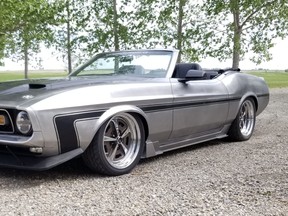Early years working with dad planted seed for opening, owning and operating a restoration shop

By the time he could walk, fabricator Lyle Vass, the son of hardworking parents, was working by his father’s side seven days a week. “My dad would drag me to the shop, where I’d lend a hand,” says Vass.
Recommended Videos
The shop was in Vass’s hometown of Lestock, Sask., a small village north of Regina. There, Vass’s dad David operated an auto body repair shop, a trucking company, and a farm. While collision repair was the main operation at Lestock Auto Body, there was always a bay set aside for a vehicle restoration. It was there, the younger Vass says, where he was put to work sanding parts or simply pushing a broom and organizing toolboxes.

“My hands were smaller, so I got the job of handling a lot of the smaller parts,” Vass, who now lives in Strathmore, Alta., says. “By the time I was 12, I was pulling engines and taking on larger projects.” At 14, Vass’s dad gave him a short wheelbase Dodge van. It was rusty and required plenty of sheet metal work. Vass made all the required patch panels by hand and was driving the van when he turned 16. “In the Seventies and Eighties, when we were restoring some of these projects, there were no repair panels to be had,” Vass says. “Unless you could find something used that was in better condition than what was at hand, we made everything from scratch.”
Vass was 21 when his dad died, and the business was sold. At that point, Vass went off to university, first in Regina, and then to Saskatoon, where he became a mechanical engineer. The lure of the oil and gas industry brought him to Calgary. Afterhours he worked in a rented two car garage on his own projects. He also took on smaller jobs for others who were restoring special interest vehicles.
His personal vehicle, a 1971 Mustang convertible was bought sight unseen. Vass then discovered the car was in worse shape than he’d been led to believe. “It was a complete rusted out basket case,” he recalls. “I did have a 1973 Mustang notchback parts car, and I used pieces of it on the convertible.”

The convertible was shortened in overall length and widened in the rear by five inches. It’s an inch narrower up front while the nose has been pushed down an inch. Everything is hidden, with no visible fasteners, plumbing or wiring. “The engine bay is what capture’s attention,” Vass says of the skillfully crafted panels that make the Mustang appear so clean. He has left the car in raw metal, without any body work, primer or paint. This showcases his talent working with sheet metal. With the Mustang on the road close to 20 years ago, people began asking Vass if he’d take on larger projects.
“My son was born in 2007, and by then I was working in directional drilling,” he says. “I was away from home for weeks at a time and tired of it. I wanted to be home for my son.”
With the thought of opening his own custom shop, Vass challenged the auto body technician exam and passed, getting his auto body ticket. He also traveled to California and Tennessee where he took metal fabrication courses. The family moved east of Calgary to Strathmore and set up on an acreage zoned for industrial use, where out of two buildings, one a 3,600 sq. ft. shop and another 2,100 sq. ft. machine shop, Vass opened Rods N Restos Classic Car Restoration Services.

The Mustang convertible is his rolling business card. He drives it every summer, and auto enthusiasts take notice, especially because it is in raw metal and nothing hides how straight the panels are. Since opening his shop, Vass has completed several builds, including a 1940 Ford pickup and a 1930 Chevy roadster. One customer offered him only minimal direction before Vass created a car of his own design.
“We work on big projects and little projects,” Vass says of the jobs he takes on to help move a restoration project along. “We’ve worked on cars and parts from Saskatchewan, Alberta and B.C., and some from the States.” Right now, he’s working on a Chevy dually truck for a client in Tucson, Arizona.

Vass offers advice to those amateur enthusiasts looking to make patch panels in a home garage. “It depends on what someone is working on in their garage, but I believe 80 per cent of the job is having the right tools, while 20 per cent of the job is knowing how to use them.” He adds, “We have many specialty tools, from stationary and portable planishing hammers to a big metal shear and brake, plus machine tools such as a lathe and mill so I can make my own tooling and dies (for specific tasks).”
Greg Williams is a member of the Automobile Journalists Association of Canada (AJAC). Have a column tip? Contact him at 403-287-1067 or [email protected]
Sign up for our newsletter Blind-Spot Monitor and follow our social channels on Instagram ,Facebook and X to stay up to date on the latest automotive news, reviews, car culture, and vehicle shopping advice.